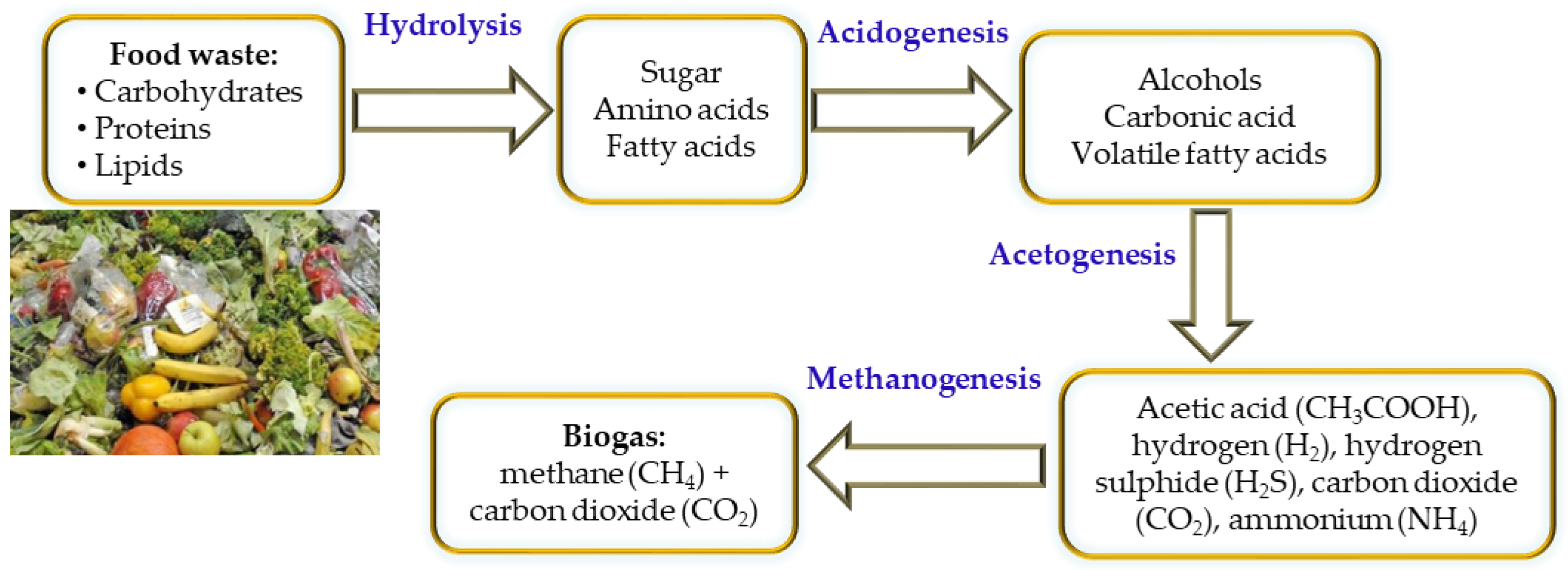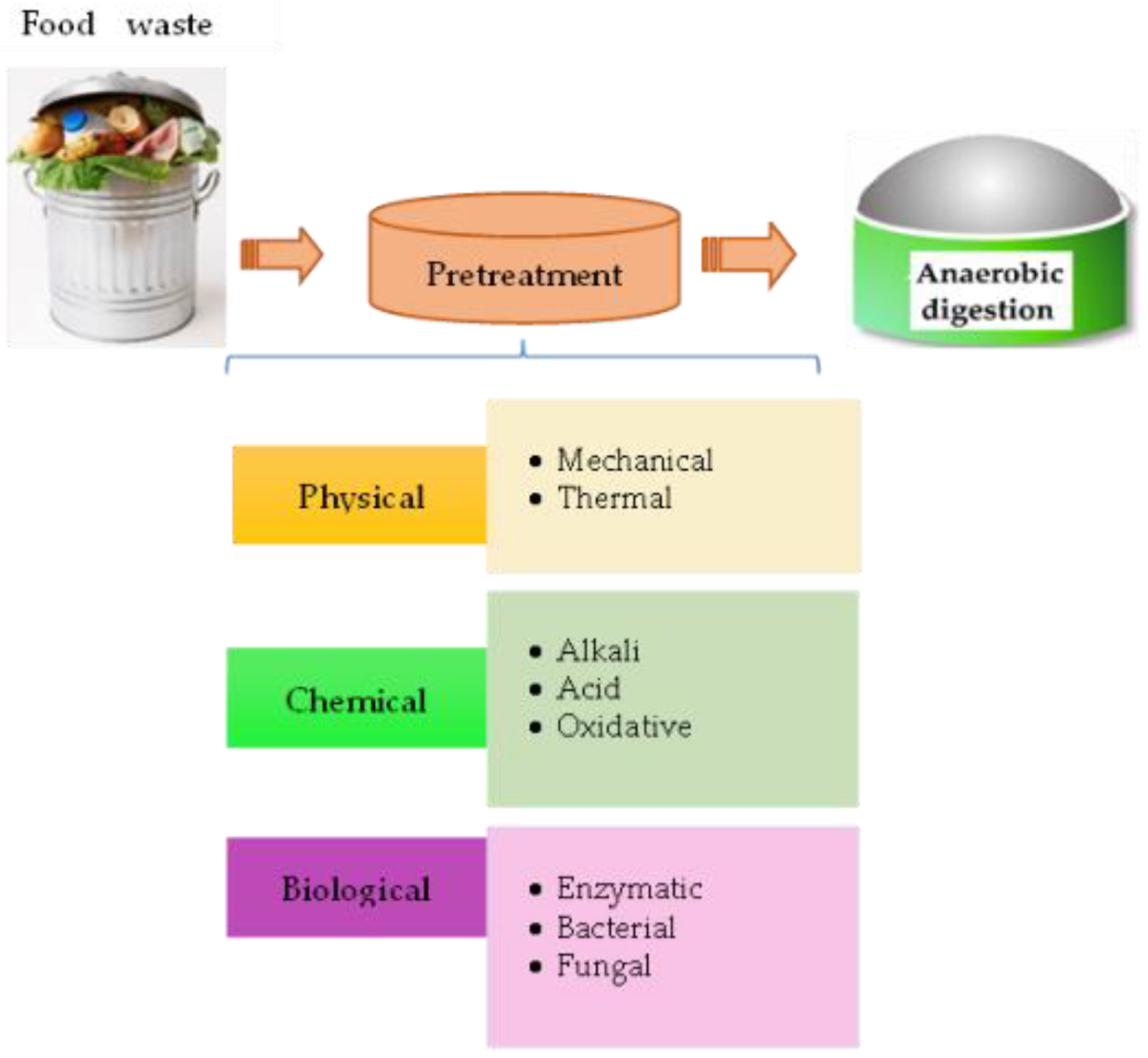Food Waste Management for Biogas Production in the Context of Sustainable Development
Abstract
1. Introduction
2. Waste Management and Sustainable Development
- Waste prevention;
- Recycling and reuse;
- Improving final disposal and control of waste.
2.1. Food Waste and SDGs
2.2. Anaerobic Digestion for Food Waste
3. Categories of Food Waste
3.1. Waste from Dairy Industry
3.2. Waste from Meat and Poultry Processing Industry
3.3. Waste from Fish Processing
3.4. Waste from the Fruit and Vegetable Industry
3.5. Waste from Cereals Processing Industry
3.6. Waste from the Brewing Industry
3.7. Waste from Wine Industry
3.8. Catering Waste
4. Utilization of Food Waste as Substrate in the AD Process
5. Food Waste Pretreatments
5.1. Physical Pretreatment
5.1.1. Mechanical Pretreatment
5.1.2. Thermal Pretreatment
5.2. Chemical Pretreatment
5.3. Biological Pretreatment
6. Conclusions
Author Contributions
Funding
Institutional Review Board Statement
Informed Consent Statement
Data Availability Statement
Conflicts of Interest
References
- Duque-Acevedo, M.; Belmonte-Urena, L.J.; Camacho-Ferre, F.; Cortes-Garcia, F.J. Agricultural waste: Review of the evolution, approaches and perspectives on alternative uses. Glob. Ecol. Conserv. 2020, 22, e00902. [Google Scholar] [CrossRef]
- Food and Agriculture Organization of the United Nations (FAO). Strategic Work of FAO for Sustainable Food and Agriculture. 2017. Available online: http://www.fao.org/3/i6488e/i6488e.pdf (accessed on 12 June 2022).
- Mu, L.; Zhang, L.; Zhu, K.; Ma, J.; Ifran, M.; Li, A. Anaerobic co-digestion of sewage sludge, food waste and yard waste: Synergistic enhancement on process stability and biogas production. Sci. Total Environ. 2019, 704, 135429. [Google Scholar] [CrossRef]
- Parthiba Karthikeyan, O.; Trably, E.; Mehariya, S.; Bernet, N.; Wong, J.W.C.; Carrere, H. Pretreatment of food waste for methane and hydrogen recovery: A review. Bioresour. Technol. 2018, 249, 1025–1039. [Google Scholar] [CrossRef]
- Ngoc, B.D.T.; Gopalakrishnan, K.; Chiu-Yue, L. An overview of food waste management in developing countries: Current status and future perspective. J. Environ. Manag. 2015, 157, 220–229. [Google Scholar]
- Thi, N.B.D.; Biswarup, S.; Chen, C.C.; Gopalakrishnan, K.; Lin, C.Y. Food waste to bioenergy via anaerobic processes. Energy Procedia 2014, 61, 307–312. [Google Scholar]
- Brian, L.; Craig, H.; James, L.; Lisa, K.; Richard, W.; Tim, S. Reducing Food Loss and Waste e Installment 2 of “Creating a Sustainable Food Future”; World Resource Institute: Washington, DC, USA, 2013. [Google Scholar]
- Daniel, H.; Natalie, G. Managing Municipal Solid Waste in Latin America and the Caribbean. Gridlines 2007, 28. Available online: https://openknowledge.worldbank.org/handle/10986/10639 (accessed on 17 May 2022).
- European Parliament. Food Waste in the EU: Millions of Tonnes of Food in the Bin. 2017. Available online: https://www.europarl.europa.eu/news/en/headlines/society/20170505STO73528/food-waste-the-problem-in-the-eu-in-numbers-infographic (accessed on 27 June 2022).
- Klaus, G.; Grunert, N.R.; De Barcellos, M.D. Circular Food Behaviors: A Literature Review. Sustainability 2021, 13, 1872. [Google Scholar]
- United Nation. Special edition: Progress towards the Sustainable Development Goals. 2019. Available online: https://undocs.org/E/2019/68 (accessed on 17 July 2022).
- Talan, A.; Tiwari, B.; Yadav, B.; Tyagi, R.D.; Drogui, P.; Wong, J.W.C. Food waste valorization: Energy production using novel integrated systems. Bioresour. Technol. 2021, 322, 124538. [Google Scholar] [CrossRef] [PubMed]
- Ebner, J.; Babbitt, C.; Winer, M.; Hilton, B.; Williamson, A. Life cycle greenhouse gas (GHG) impacts of a novel process for converting food waste to ethanol and co-products. Appl. Energy 2014, 130, 86–93. [Google Scholar] [CrossRef]
- European Parliament. Directive 2008/98/EC of the European Parliament and the Council of 19 November 2008 on Waste and Repealing Certain Directives. 2008. Available online: https://eur-lex.europa.eu/legal-content/en/TXT/PDF/?uri=CELEX:02008L0098-20180705&from=EN (accessed on 17 May 2022).
- Kim, M.H.; Song, Y.E.; Song, H.B.; Kim, J.W.; Hwang, S.J. Evaluation of food waste disposal options by LCC analysis from the perspective of global warming: Jungnang case, South Korea. Waste Manag. 2011, 31, 2112–2120. [Google Scholar] [CrossRef] [PubMed]
- Pollution Control Department and Ministry of Natural Resources and Environment. Thailand state of Pollution (Bangkok). 2010. Available online: http://infofile.pcd.go.th/mgt/Report_Eng2553.pdf (accessed on 17 June 2022).
- Abdelsalam, E.; Samer, M.; Attia, Y.A.; Abdel-Hadi, M.A.; Hassan, H.E.; Badr, Y. Effects of Co and Ni nanoparticles on biogas and methane production from anaerobic digestion of slurry. Energy Convers. Manag. 2017, 141, 108–119. [Google Scholar] [CrossRef]
- Fei, X.; Chen, T.; Jia, W.; Shan, Q.; Hei, D.; Ling, Y.; Feng, J.; Feng, H. Enhancement effect of ionizing radiation pretreatment on biogas production from anaerobic fermentation of food waste. Radiat. Phys. Chem. 2020, 168, 108534. [Google Scholar] [CrossRef]
- Maranon, E.; Castrillon, L.; Quiroga, G.; Fernandez-Nava, Y.; Gomez, L.; Garcia, M.M. Co-digestion of cattle manure with food waste and sludge to increase biogas production. Waste Manag. 2012, 32, 1821–1825. [Google Scholar] [CrossRef]
- Zhang, J.Y.; Chen, L.; Juan, T.; Liu, J.W.; Liu, J.B.; Yu, D.W.; Wang, Y.W.; Chen, M.X.; Wei, Y.S. Optimization and microbial community analysis of anaerobic co-digestion and food waste and sewage sludge based on microwave pretreatment. Bioresour. Technol. 2016, 200, 253–261. [Google Scholar] [CrossRef] [PubMed]
- Naran, E.; Toor, U.A.; Kim, D.-J. Effect of pretreatment and anaerobic co-digestion of food waste and waste activated sludge on stabilization and methane production. Int. Biodeterior. Biodegrad. 2016, 113, 17–21. [Google Scholar] [CrossRef]
- Ma, J.; Duong, T.H.; Smits, M.; Verstraete, W.; Carballa, M. Enhanced biomethanation of kitchen waste by different pre-treatment. Bioresour. Technol. 2011, 102, 592–599. [Google Scholar] [CrossRef]
- Chu, L.; Wang, J.; Wang, B. Effect of gamma irradiation on activities and physicochemical characteristics of sewage sludge. Biochem. Eng. J. 2011, 54, 34–39. [Google Scholar] [CrossRef]
- Yu, I.K.M.; Tsang, D.C.W.; Yip, A.C.K.; Chen, S.S.; Ok, Y.S.; Poon, C.S. Valorization of food waste into hydroxymethylfurfural: Dual role of metal ions in successive conversion steps. Bioresource Technol. 2016, 219, 338–347. [Google Scholar] [CrossRef]
- Chen, S.S.; Yu, I.K.M.; Tsang, D.C.W.; Yip, A.C.K.; Khan, E.; Wang, L.; Ok, Y.S.; Poon, C.S. Valorization of cellulosic food waste into levulinic acid catalyzed by heterogeneous Brønsted acids: Temperature and solvent effects. Chem. Eng. J. 2017, 327, 328–335. [Google Scholar] [CrossRef]
- ElMekawy, A.; SriElMekawy, A.; Srikanth, S.; Vanbroekhoven, K.; De Wever, H.; Pant, D. Bioelectrocatalytic valorization of dark fermentation effluents by acetate oxidizing bacteria in bioelectrochemical system (BES). J. Power Sources 2014, 262, 183–191. [Google Scholar] [CrossRef]
- Chandrasekhar, K.; Kumar, A.N.; Raj, T.; Kumar, T.; Kim, S.H. Bioelectrochemical system-mediated waste valorization. Syst. Microbiol. Biomanufacturing 2021, 1, 432–443. [Google Scholar] [CrossRef]
- Bernstad, A.; la Cour Jansen, J. Review of comparative LCAs of food waste management systems—Current status and potential improvements. Waste Manag. 2012, 32, 2439–2455. [Google Scholar] [CrossRef]
- Boldrin, A.; Andersen, J.K.; Møller, J.; Christensen, T.H.; Favoino, E. Composting and compost utilization: Accounting of greenhouse gases and global warming contributions. Waste Manag. Res. 2009, 27, 800–812. [Google Scholar] [CrossRef] [PubMed]
- Laurant, A.; Bakas, I.; Clavreul, J.; Bernstad, A.; Niero, M.; Gentil, E.; Hauschild, M.Z.; Christensen, T.H. Review of LCA studies of solid waste management systems e part I: Lessons learned and perspective. Waste Manag. 2014, 34, 573–588. [Google Scholar] [CrossRef]
- Morris, J.; Matthews, S.; Morawski, C. Review of LCAs on Organics Management Methods and Development of an Environmental Hierarchy; Alberta Environment: Edmonton, AB, Canada, 2011. [Google Scholar]
- Tiffany, M.W.; Xinni Xiong, M.; Tsang, C.W.; Iris, K.M.; Yu, C.S.P. Sustainable food waste management towards circular bioeconomy: Policy review, limitations and opportunities. Bioresour. Technol. 2020, 297, 122497. [Google Scholar]
- GEF. A Strategy for a Bio-Based Economy. 2012. Available online: https://gef.eu/wp-content/uploads/2017/01/A_strategy_for_a_bio-based_economy.pdf (accessed on 24 June 2022).
- Institute for European Environmental Policy. Promoting a Circular, Sustainable Bioeconomy—Delivering the Bioeconomy Society Needs. 2018. Available online: https://ieep.eu/news/promoting-a-circular-sustainable-bioeconomy-delivering-the-bioeconomy-societyneeds (accessed on 17 July 2022).
- UN Department of Economic and Social Affairs. Sustainable Development Goals: Sustainable Development Knowledge Platform. 2015. Available online: https://sustainabledevelopment.un.org/ (accessed on 25 June 2022).
- Kaza, S.; Yao, L.C.; Bhada-Tata, P.; Van Woerden, F. What a Waste 2.0: A Global Snapshot of Solid Waste Management to 2050; Published Book, Urban Development; World Bank: Washington, DC, USA, 2018; Available online: https://www.worldbank.org/en/news/immersive-story/2018/09/20/what-a-waste-an-updated-look-into-the-future-of-solid-waste-management (accessed on 1 July 2022).
- Grosso, M.; Falasconi, L. Addressing food wastage in the framework of the UN Sustainable Development Goals. Waste Manag. Res. 2018, 36, 97–98. [Google Scholar] [CrossRef]
- Hao, H.T.N.; Karthikeyan, O.P.; Heimann, K. Bio-refining of carbohydrate-rich food waste for biofuels. Energies 2015, 8, 6350–6364. [Google Scholar] [CrossRef]
- Gustavsson, J.; Cederberg, C.; Sonesson, U.; van Otterdijk, R.; Meybeck, A. Global Food Losses and Food Waste: Extent, Causes and Prevention; Food and Agriculture Organization of the United Nations: Rome, Italy, 2011. [Google Scholar]
- Melikoglu, M.; Lin, C.; Webb, C. Analysing global food waste problem: Pinpointing the facts and estimating the energy content. Open Eng. 2013, 3, 157–164. [Google Scholar] [CrossRef]
- Chen, H.; Jiang, W.; Yang, Y.; Yang, Y.; Man, X. State of the art on food waste research: A bibliometrics study from 1997 to 2014. J. Clean. Prod. 2017, 140, 840–846. [Google Scholar] [CrossRef]
- Nicastro, R.; Carillo, P. Food Loss and Waste Prevention Strategies from Farm to Fork. Sustainability 2021, 13, 5443. [Google Scholar] [CrossRef]
- Grimberg, S.J.; Hilderbrandt, D.; Kinnunen, M.; Rogers, S. Anaerobic digestion of food waste through the operation of a mesophilic two-phase pilot scale digester e assessment of variable loadings on system performance. Bioresour. Technol. 2015, 178, 226–229. [Google Scholar] [CrossRef] [PubMed]
- Schott, A.B.S.; Andersson, T. Food waste minimization from a life-cycle perspective. J. Environ. Manag. 2015, 147, 219–226. [Google Scholar] [CrossRef] [PubMed]
- Vandermeersch, T.; Alvarenga, R.A.F.; Ragaert, P.; Dewulf, J. Environmental sustainability assessment of food waste valorization options. Resour. Conserv. Recycl. 2014, 87, 57–64. [Google Scholar] [CrossRef]
- Kranert, M.; Hafner, G.; Barabosz, J.; Schneider, F.; Lebersorger, S.; Scherhaufer, S.; Schuller, H.; Leverenz, D. Determination of Discarded Food and Proposals for a Minimization of Food Wastage in Germany: Abridged Version; University Stuttgart Institute for Sanitary Engineering: Stuttgart, Germany, 2012. [Google Scholar]
- Stenmarck, Å.; Jensen, C.; Quested, T.; Moates, G. Estimates of European Food Waste Levels (FUSION Reducing Food Waste through Social Innovation); IVL Swedish Environmental Research Institute: Stockholm, Sweden, 2016. [Google Scholar]
- Ojha, S.; Bußler, S.; Schlüter, O.K. Food waste valorization and circular economy concepts in insect production and processing. Waste Manag. 2020, 118, 600–609. [Google Scholar] [CrossRef] [PubMed]
- Alexopoulos, T.A. The growing importance of natural gas as a predictor for retail electricity prices in US. Energy 2017, 137, 219–233. [Google Scholar] [CrossRef]
- Li, L.; He, Q.; Ma, Y.; Wang, X.; Peng, X. Dynamics of microbial community in a mesophilic anaerobic digester treating food waste: Relationship between community structure and process stability. Bioresour. Technol. 2015, 189, 113–120. [Google Scholar] [CrossRef]
- Perrigault, T.; Weatherford, V.; Martí-Herrero, J.; Poggio, D. Towards thermal design optimization of tubular digesters in cold climates: A heat transfer model. Bioresour. Technol. 2012, 124, 259–268. [Google Scholar] [CrossRef]
- Shah, F.A.; Mahmood, Q.; Rashid, N.; Pervez, A.; Raja, I.A.; Shah, M.M. Co-digestion, pretreatment and digester design for enhanced methanogenesis. Renew. Sustain. Energy Rev. 2015, 42, 627–642. [Google Scholar] [CrossRef]
- Yi, J.; Dong, B.; Jin, J.; Dai, X. Effect of increasing total solids contents on anaerobic digestion of food waste under mesophilic conditions: Performance and microbial characteristics analysis. PLoS ONE 2014, 9, e102548. [Google Scholar] [CrossRef]
- Ezeah, C.; Stokes, A.D.; Roberts, C.L. Assessment of gas yield potentials of selected feedstocks in a small scale Anaerobic digestion plant: Case study, L. Reule bioenergy plant, IOSR. J. Environ. Sci. Toxicol. Food Technol. 2014, 8, 68–76. [Google Scholar] [CrossRef]
- Wang, H.; Fotidis, I.A.; Angelidaki, I. Ammonia effect on hydrogenotrophic methanogens and syntrophic acetate-oxidizing bacteria. FEMS Microbiol. Ecol. 2015, 91, fiv130. [Google Scholar] [CrossRef] [PubMed]
- Mahmood, R.; Parshetti, G.K.; Balasubramanian, R. Energy, exergy and techno-economic analyses of hydrothermal oxidation of food waste to produce hydro-char and bio-oil. Energy 2016, 102, 187–198. [Google Scholar] [CrossRef]
- Tayyab, A.; Ahmad, Z.; Mahmood, T.; Khalid, A.; Qadeer, S.; Mahmood, S.; Andleeb, S.; Anjum, M. Anaerobic co-digestion of catering food waste utilizing parthenium hysterophorus as co-substrate for biogas production. Biomass Bioenergy 2019, 124, 74–82. [Google Scholar] [CrossRef]
- Ren, Y.; Yu, M.; Wu, C.; Wang, Q.; Gao, M.; Huang, Q.; Liu, Y. A comprehensive review on food waste anaerobic digestion: Research updates and tendencies. Bioresour. Technol. 2018, 247, 1069–1076. [Google Scholar] [CrossRef] [PubMed]
- Panigrahi, S.; Sharma, H.B.; Dubey, B.K. Anaerobic co-digestion of food waste with pretreated yard waste: A comparative study of methane production, kinetic modeling and energy balance. J. Clean. Prod. 2020, 243, 118480. [Google Scholar] [CrossRef]
- Cooper, R. Trends in the Anaerobic Digestion of Food Waste, Rubicon Blog. 2019. Available online: https://www.rubicon.com/blog/anaerobic-digestion-food-waste/ (accessed on 25 July 2022).
- Garcia-Garcia, G.; Wooley, E.; Rahimifard, S.; Colwill, J.; White, R.; Needham, L. A Methodology for Sustainable Management of Food Waste. Waste Biomass Valor. 2017, 8, 2209–2227. [Google Scholar] [CrossRef] [PubMed]
- Lin, C.; Pfaltzgraff, L.A.; Herrero-Davila, L.; Mubofu, E.B.; Solhy, A.; Clark, P.J.; Koutinas, A.; Kopsahelis, N.; Stamatelatou, K.; Dickson, F.; et al. Food waste as a valuable resource for the production of chemicals, materials and fuels. Current situation and global perspective. Energy Environ. Sci. 2013, 6, 426–464. [Google Scholar] [CrossRef]
- Garcia-Garcia, G.; Woolley, E.; Rahimifard, S. A framework for a more efficient approach to food waste management. Int. J. Food Eng. 2015, 1, 65–72. [Google Scholar] [CrossRef]
- Food Loss and Waste Protocol: Food Loss and Waste Accounting and Reporting Standard. 2016. Available online: https://flwprotocol.org/wp-content/uploads/2017/05/FLW_Standard_final_2016.pdf (accessed on 27 July 2022).
- Pour, F.H.; Makkawi, Y.T. A review of post-consumption food waste management and its potentials for biofuel production. Energy Rep. 2021, 7, 7759–7784. [Google Scholar] [CrossRef]
- Selvam, A.; Udayakumar, M.; Banu, R.J.; Wong, J. Sustainable Food Waste Management: Resource Recovery and Treatment. In Current Developments in Biotechnology and Bioengineering; Wong, J., Kaur, G., Taherzadeh, M., Pandey, A., Lasaridi, K., Eds.; Elsevier: Amsterdam, The Netherlands, 2021; pp. 11–41. [Google Scholar]
- Sawalha, H.; Maghalseh, M.; Qutaina, J.; Junaidi, K.; Rene, R. Removal of hydrogen sulfide from biogas using activated carbon synthesized from different locally available biomass wastes—A case study from Palestine. Bioengineered 2020, 11, 607–618. [Google Scholar] [CrossRef]
- Sar, T.; Harirchi, S.; Ramezani, M.; Bulkan, G.; Akbas, M.Y.; Pandey, A.; Taherzadeh, M.J. Potential utilization of dairy industries by-products and wastes through microbial processes: A critical review. Sci. Total Environ. 2022, 810, 152253. [Google Scholar] [CrossRef] [PubMed]
- Blaschek, K.M.; Wendorff, W.L.; Rankin, S.A. Survey of salty and sweet whey composition from various cheese plants in Wisconsin. J. Dairy Sci. 2007, 90, 2029–2034. [Google Scholar] [CrossRef] [PubMed]
- Awasthi, M.K.; Paul, A.; Kumar, V.; Sar, T.; Kumar, D.; Sarsaiya, S.; Liu, H.; Zhang, Z.; Binod, P.; Sindhu, R.; et al. Recent trends and developments on integrated biochemical conversion process for valorization of dairy waste to value added bioproducts: A review. Bioresour. Technol. 2021, 344, 126193. [Google Scholar] [CrossRef] [PubMed]
- Asunis, F.; De Gioannis, G.; Isipato, M.; Muntoni, A.; Polettini, A.; Pomi, R.; Rossi, A.; Spiga, D. Control of fermentation duration and pH to orient biochemicals and biofuels production from cheese whey. Bioresour. Technol. 2019, 289, 121722. [Google Scholar] [CrossRef]
- Wzorek, Z.; Konopka, M.; Cholewa, J.; Klamecki, G.; Bajcer, T. Waste release from meat processing. Pol. J. Chem. Technol. 2007, 9, 91–94. [Google Scholar] [CrossRef]
- Banks, C.; Wang, Z. Treatment of Meat Wastes. In Handbook of Industrial and Hazardous Wastes Treatment, 2nd ed.; CRC Press Taylor & Francis Group: New York, USA, UK, 2006; pp. 68–100. [Google Scholar]
- Muduli, S.; Champati, A.; Popalghat, H.K.; Patel, P.; Sneha, K.R. Poultry waste management: An approach for sustainable development. Int. J. Adv. Sci. 2019, 4, 8–14. [Google Scholar]
- Salminen, E.; Rintala, J. Anaerobic digestion of organic solid poultry slaughterhouse waste—A review. Bioresour. Technol. 2002, 83, 13–26. [Google Scholar] [CrossRef]
- Mozhiarasi, V.; Natarajan, T.S. Slaughterhouse and poultry wastes: Management practices, feedstocks for renewable energy production, and recovery of value added products. Biomass Convers. Biorefinery 2022, 2022, 1–24. [Google Scholar] [CrossRef]
- Coppola, D.; Lauritano, C.; Esposito, F.P.; Riccio, G.; Rizzo, C.; de Pascale, D. Fish Waste: From Problem to Valuable Resource. Mar. Drugs. 2021, 19, 116. [Google Scholar] [CrossRef]
- Lanari, D.; Franci, C. Biogas Production from Solid Wastes Removed from Fish Farm Effluents. Aquat. Living Resour. 1998, 11, 289–295. [Google Scholar] [CrossRef]
- McDermott, B.L.; Chalmers, A.D.; Goodwin, A.S. Ultrasonication as a Pre-Treatment Method for the Enhancement of the Psychrophilic Anaerobic Digestion of Aquaculture Effluents. Environ. Technol. 2001, 22, 823–830. [Google Scholar] [CrossRef] [PubMed]
- Marchaim, U.; Gelman, A.; Braverman, Y. Reducing Waste Contamination from Animal-Processing Plants by Anaerobic Thermophilic Fermentation and by Flesh Fly Digestion. Appl. Biochem. Biotechnol. 2003, 109, 107–115. [Google Scholar] [CrossRef]
- Gebaur, R. Mesophilic Anaerobic Treatment of Sludge from Saline Fish Farm Effluents with Biogas production. Bioresour. Technol. 2004, 93, 155–167. [Google Scholar] [CrossRef] [PubMed]
- Mshandete, A.; Kivaisi, A.; Rubindamayugi, M.; Mattiasson, B. Anaerobic Batch Co-digestion of Sisal Pulp and Fish Wastes. Bioresour. Technol. 2004, 95, 19–24. [Google Scholar] [CrossRef]
- Gebaur, R.; Eikebrokk, B. Mesophilic Anaerobic Treatment of Sludge from Salmon Smolt Hatching. Bioresour. Technol. 2006, 97, 2389–2401. [Google Scholar] [CrossRef]
- More, P.K.; Singh, S. Waste utilization of fruits and vegetables. South Asian J. Food Technol. Environ. 2018, 4, 605–615. [Google Scholar]
- Jiang, Y.; Heaven, S.; Banks, C.J. Strategies for stable anaerobic digestion of vegetable waste. Renew. Energy 2016, 44, 206–214. [Google Scholar] [CrossRef]
- Tedesco, D.E.A.; Scarioni, S.; Tava, A.; Panseri, S.; Zuorro, A. Fruit and Vegetable Wholesale Market Waste: Safety and Nutritional Characterization for Their Potential Re-Use in Livestock Nutrition. Sustainability 2021, 13, 9478. [Google Scholar] [CrossRef]
- Kothari, R.; Tyagi, V.V.; Pathak, A. Waste-to-energy: A way from renewable energy sources to sustainable development. Renew. Sustain. Energy Rev. 2010, 14, 3164–3170. [Google Scholar] [CrossRef]
- Plazzotta, S.; Manzocco, L.; Nicoli, M.C. Fruit and vegetable waste management and the challenge of fresh-cut salad. Trends Food Sci. Technol. 2017, 63, 51–59. [Google Scholar] [CrossRef]
- Velebil, J.; Tamelová, B.; Malaťak, J. Hydrothermal carbonization and torrefaction of cabbage waste. Agron. Res. 2019, 17, 862–871. [Google Scholar]
- Dubrovskis, V.; Plume, I. Biogas from wastes of pumpkin, marrow and apple. Agron. Res. 2017, 15, 69–78. [Google Scholar]
- Shen, F.; Yuan, H.; Pang, Y.; Chen, S.; Zhu, B.; Zou, D.; Li, X. Performances of anaerobic co-digestion of fruit & vegetable waste (FVW) and food waste (FW): Singlephase vs. two-phase. Bioresour. Technol. 2013, 144, 80–85. [Google Scholar]
- Lin, J.; Zuo, J.; Gan, L.; Li, P.; Liu, F.; Wang, K.; Chen, L.; Gan, H. Effects of mixture ratio on anaerobic co-digestion with fruit and vegetable waste and food waste of China. J. Environ. Sci. 2011, 23, 1403–1408. [Google Scholar] [CrossRef]
- Skendi, A.; Zinoviadou, K.G.; Papageorgiou, M.; Rocha, J.M. Advances on the Valorization and Functionalization of By-Products and Wastes from Cereal-Based Processing Industry. Foods 2020, 9, 1243. [Google Scholar] [CrossRef]
- Fillaudeau, L.; Blanpain-Avet, P.; Daufin, G. Water, wastewater and waste management in brewing industries. J. Clean. Prod. 2006, 14, 463–471. [Google Scholar] [CrossRef]
- dos Santos Mathias, R.T.; de Mello, M.P.P.; Camporese Sérvulo, E.F. Solid wastes in brewing process: A review. J. Brew. Distilling. 2014, 5, 1–9. [Google Scholar]
- Karlovic, A.; Juric, A.; Coric, N.; Habschied, K.; Krstanovic, V.; Mastanjevic, K. By-Products in the Malting and Brewing Industries—Re-Usage Possibilities. Fermentation 2020, 6, 82. [Google Scholar] [CrossRef]
- Zupancic, G.D.; Skrjanec, I.; Logar, R.M. Anaerobic co-digestion of excess brewery yeast in a granular biomass reactor to enhance the production of biomethane. Bioresour. Technol. 2012, 124, 328–337. [Google Scholar] [CrossRef]
- Kalli, E.; Lappa, I.; Bouchagier, P.; Tarantilis, P.A.; Skotti, E. Novel application and industrial exploitation of winery by-products. Bioresour. Bioprocess. 2018, 5, 46. [Google Scholar] [CrossRef]
- Da Ros, C.; Cavinato, C.; Cecchi, F.; Bolzonella, D. Anaerobic co-digestion of winery waste and waste activated sludge: Assessment of process feasibility. Water Sci. Technol. 2014, 69, 269–277. [Google Scholar] [CrossRef] [PubMed]
- Moletta, R. Winery and distillery wastewater treatment by anaerobic digestion. Water Sci. Technol. 2005, 51, 137–144. [Google Scholar] [CrossRef]
- Rodríguez, L.; Villaseñor, J.; Fernández, F.J.; Buendía, I.M. Anaerobic co-digestion of winery wastewater. Water Sci. Technol. 2007, 56, 49–54. [Google Scholar] [CrossRef][Green Version]
- Fountoulakis, M.S.; Drakopoulou, S.; Terzakis, S.; Georgaki, E.; Manios, T. Potential for methane production from typical Mediterranean agro-industrial by-products. Biomass Bioenergy 2008, 32, 155–161. [Google Scholar] [CrossRef]
- Lamoolphak, W.; Goto, M.; Sasaki, M.; Suphantharika, M.; Muangnapoh, C.; Prommuag, C.; Shotipruk, A. Hydrothermal decomposition of yeast cells for production of proteins and amino acids. J. Hazard. Mater. 2006, 137, 1643–1648. [Google Scholar] [CrossRef]
- Thakkar, A.; Barbera, E.; Sforza, E.; Bertucco, A.; Davis, R.; Kumar, S. Flash hydrolysis of yeast (Saccharomyces cerevisiae) for protein recovery. J. Supercrit. Fluids 2021, 173, 105240. [Google Scholar] [CrossRef]
- Tsegaye, B.; Jaiswal, S.; Jaiswal, A.K. Food Waste Biorefinery: Pathway towards Circular Bioeconomy. Foods 2021, 10, 1174. [Google Scholar] [CrossRef]
- Socas-Rodriguez, B.; Alvarez-Rivera, G.; Valdes, A.; Ibanez, E.; Cifuentes, A. Food by-products and food wastes: Are they safe enough for their valorization? Trends Food Sci. Technol. 2021, 114, 133–147. [Google Scholar] [CrossRef]
- Dahiya, S.; Sarkar, O.; Swamy, Y.V.; Venkata Mohan, S. Acidogenic fermentation of food waste for volatile fatty acid production with co-generation of biohydrogen. Bioresour. Technol. 2015, 182, 103–113. [Google Scholar] [CrossRef]
- Kannah, R.Y.; Merrylin, J.; Devi, T.P.; Kavitha, S.; Sivashanmugam, P.; Kumar, G.; Banu, J.R. Food waste valorization: Biofuels and value added product recovery. Bioresour. Technol. Rep. 2020, 11, 100524. [Google Scholar] [CrossRef]
- Meena, R.A.A.; Banu, J.R.; Kannah, R.Y.; Yogalakshmi, K.N.; Kumar, G. Biohythane production from food processing wastes—Challenges and perspectives. Bioresour. Technol. 2020, 298, 122449. [Google Scholar] [CrossRef] [PubMed]
- Mahyari, Z.F.; Khorasanizadeh, Z.; Khanali, M.; Mahyari, K.F. Biodiesel production from slaughter wastes of broiler chicken: A potential survey in Iran. SN Appl. Sci. 2021, 3, 57. [Google Scholar] [CrossRef]
- Kiran, E.U.; Trzcinski, A.P.; Liu, Y. Enhancing the hydrolysis and methane production potential of mixed food waste by an effective enzymatic pretreatment. Bioresour. Technol. 2015, 183, 47–52. [Google Scholar] [CrossRef] [PubMed]
- Paraschiv, G.; Ungureanu, N.; Dincă, M.; Zăbavă, B.Ș.; Ferdeș, M.; Moiceanu, G.; Toma, L. Biogas Production and the Environmental Impact; Politehnica Press: Bucharest, Romania, 2020; pp. 11–23. [Google Scholar]
- Nasrin, A.B.; Abdul Raman, A.A.; Bukhari, N.A.; Sukiran, M.A.; Buthiyappan, A.; Subramaniam, V.; Abdul Aziz, A.; Loh, S.K. A critical analysis on biogas production and utilization potential from palm oil mill effluent. J. Clean. Prod. 2022, 361, 132040. [Google Scholar] [CrossRef]
- Pandit, G.K.; Tiwari, R.K.; Singh, S.V.; Singh, M. Recent Advances in Biogas Production from Food Waste. In Food Waste to Green Fuel: Trend & Development. Clean Energy Production Technologies; Srivastava, N., Malik, M.A., Eds.; Springer: Singapore, 2022; pp. 125–151. [Google Scholar]
- Paritosh, K.; Kushwaha, S.K.; Yadav, M.; Pareek, N.; Chawade, A.; Vivekanand, V. Food waste to energy: An overview of sustainable approaches for food waste management and nutrient recycling. BioMed Res. Int. 2017, 2017, 370927. [Google Scholar] [CrossRef]
- Chowdhury, H.; Chowdhury, T.; Barua, P.; Rahman, M.S.; Hossain, N.; Khan, A. Biofuel production from food waste biomass and application of machine learning for process management. In Advanced Technology for the Conversion of Waste into Fuels and Chemicals: Biological Processes; Khan, A., Jawaid, M., Pizzi, A., Azum, N., Asiri, A., Isa, I., Eds.; Elsevier: Amsterdam, The Netherlands, 2021; Volume 1, pp. 77–97. [Google Scholar]
- Narasimmalu, A.; Ramasamy, R. Food Processing Industry Waste and Circular Economy. IOP Conf. Ser. Mater. Sci. Eng. 2020, 955, 012089. [Google Scholar] [CrossRef]
- Pham, T.P.T.; Kaushik, R.; Parshetti, G.K.; Mahmood, R.; Balasubramanian, R. Food waste-to-energy conversion technologies: Current status and future directions. Waste Manag. 2015, 38, 399–408. [Google Scholar] [CrossRef]
- Cheong, W.L.; Chan, Y.J.; Tiong, T.J.; Chong, W.C.; Kiatkittipong, W.; Kiatkittipong, K.; Mohamad, M.; Daud, H.; Suryawan, I.W.K.; Sari, M.M.; et al. Anaerobic Co-Digestion of Food Waste with Sewage Sludge: Simulation and Optimization for Maximum Biogas Production. Water 2022, 14, 1075. [Google Scholar] [CrossRef]
- Aguilar, M.C.; Wang, Y.D.; Roskilly, T.; Pathare, P.B.; Lamidi, R.O. Biogas from anaerobic co-digestion of food waste and primary sludge for cogeneration of power and heat. Energy Procedia 2017, 142, 70–76. [Google Scholar] [CrossRef]
- Lv, Y.; Chang, N.; Li, Y.Y.; Liu, Y. Anaerobic co-digestion of food waste with municipal solid waste leachate: A review and prospective application with more benefits. Resour. Conserv. Recycl. 2021, 174, 105832. [Google Scholar] [CrossRef]
- Kuo, J.; Dow, J. Biogas production from anaerobic digestion of food waste and relevant air quality implications. J. Air Waste Manag. Assoc. 2017, 67, 1000–1011. [Google Scholar] [CrossRef]
- Antonopoulou, G.; Stamatelatou, K.; Venetsaneas, N.; Kornaros, M.; Lyberatos, G. Biohydrogen and Methane Production from Cheese Whey in a Two-Stage Anaerobic Process. Ind. Eng. Chem. Res. 2008, 47, 5227–5233. [Google Scholar] [CrossRef]
- Montalvo, S.; Martinez, J.; Castillo, A.; Huiliñir, C.; Borja, R.; Garcia, V.; Salazar, R. Sustainable energy for a winery through biogas production and its utilization: A Chilean case study. Sustain. Energy Technol. Assess. 2020, 37, 100640. [Google Scholar] [CrossRef]
- Miller, K.E.; Herman, T.; Philipinanto, D.A.; Davis, S.C. Anaerobic Digestion of Food Waste, Brewery Waste, and Agricultural Residues in an Off-Grid Continuous Reactor. Sustainability 2021, 13, 6509. [Google Scholar] [CrossRef]
- Szaja, A.; Montusiewicz, A.; Lebiocka, M.; Bis, M. The effect of brewery spent grain application on biogas yields and kinetics in co-digestion with sewage sludge. PeerJ 2020, 8, e10590. [Google Scholar] [CrossRef]
- Arshad, M.; Bano, I.; Khan, N.; Shahzad, M.I.; Younus, M.; Abbas, M.; Iqbal, M. Electricity generation from biogas of poultry waste: An assessment of potential and feasibility in Pakistan. Renew. Sustain. Energy Rev. 2018, 81, 1241–1246. [Google Scholar] [CrossRef]
- Linyi, C.; Yujie, Q.; Buqing, C.; Chenglong, W.; Shaohong, Z.; Renglu, C.; Shaohua, Y.; Lan, Y.; Zhiju, L. Enhancing degradation and biogas production during anaerobic digestion of food waste using alkali pretreatment. Environ. Res. 2020, 188, 109743. [Google Scholar] [CrossRef]
- Chen, T.; Shen, D.; Jin, Y.; Li, H.; Yu, Z.; Feng, H.; Long, Y.; Yin, J. Comprehensive evaluation of environ-economic benefits of anaerobic digestion technology in an integrated food waste-based methane plant using a fuzzy mathematical model. Appl. Energy 2017, 208, 666–677. [Google Scholar] [CrossRef]
- UN. Transforming Our World: The 2030 Agenda for Sustainable Development Preamble; United Nations: New York, NY, USA, 2015; ISBN 9781138029415. [Google Scholar]
- Fei, X.; Jia, W.; Chen, T.; Ling, Y. Life cycle assessment of food waste anaerobic digestion with hydrothermal and ionizing radiation pretreatment. J. Clean. Prod. 2022, 338, 130611. [Google Scholar] [CrossRef]
- Deepanraj, B.; Sivasubramanian, V.; Jayaraj, S. Effect of substrate pretreatment on biogas production through anaerobic digestion of food waste. Int. J. Hydrog. Energy 2017, 42, 26522–26528. [Google Scholar] [CrossRef]
- Ariunbaatar, J.; Panico, A.; Esposito, G.; Pirozzi, F.; Lens, P.N.L. Pretreatment methods to enhance anaerobic digestion of organic solid waste. Appl. Energy 2014, 123, 143–156. [Google Scholar] [CrossRef]
- Du, C.; Abdullah, J.J.; Greetham, D.; Fu, D.; Yu, M.; Ren, L.; Li, S.; Lu, D. Valorization of food waste into biofertiliser and its field application. J. Clean. Prod. 2018, 187, 273–284. [Google Scholar] [CrossRef]
- Kamusoko, R.; Jingura, R.; Parawira, W.; Sanyika, W. Comparison of pretreatment methods that enhance biomethane production from crop residues—A systematic review. Biofuel Res. J. 2019, 6, 1080–1089. [Google Scholar] [CrossRef]
- Mirmohamadsadeghi, S.; Karimi, K.; Tabatabaei, M.; Aghbashlo, M. Biogas production from food wastes: A review on recent developments and future perspectives. Bioresour. Technol. 2019, 7, 100202. [Google Scholar] [CrossRef]
- Izumi, K.; Okishio, Y.; Nagao, N.; Niwa, C.; Yamamoto, S.; Toda, T. Effects of particle size on anaerobic digestion of food waste. Int. Biodeterior. Biodegrad. 2010, 64, 601–608. [Google Scholar] [CrossRef]
- Quiroga, G.; Castrillón, L.; Fernández-Nava, Y.; Marañón, E.; Negral, L.; Rodríguez-Iglesias, J.; Ormaechea, P. Effect of ultrasound pre-treatment in the anaerobic co-digestion of cattle manure with food waste and sludge. Bioresour. Technol. 2014, 154, 74–79. [Google Scholar] [CrossRef]
- Zou, L.; Ma, C.; Liu, J.; Li, M.; Ye, M.; Qian, G. Pretreatment of food waste with high voltage pulse discharge towards methane production enhancement. Bioresour. Technol. 2016, 222, 82–88. [Google Scholar] [CrossRef]
- Liu, X.; Wang, W.; Gao, X.; Zhou, Y.; Shen, R. Effect of thermal pretreatment on the physical and chemical properties of municipal biomass waste. Waste Manag. 2012, 32, 249–255. [Google Scholar] [CrossRef]
- Ariunbaatar, J.; Panico, A.; Yeh, D.H.; Pirozzi, F.; Lens, P.N.L.; Esposito, G. Enhanced mesophilic anaerobic digestion of food waste by thermal pretreatment: Substrate versus digestate heating. Waste Manag. 2015, 46, 176–181. [Google Scholar] [CrossRef]
- El Gnaoui, Y.; Karouach, F.; Bakraoui, M.; Barz, M.; El Bari, H. Mesophilic anaerobic digestion of food waste: Effect of thermal pretreatment on improvement of anaerobic digestion process. Energy Rep. 2020, 6, 417–422. [Google Scholar] [CrossRef]
- Gianico, A.; Gallipoli, A.; Gazzola, G.; Pastore, C.; Tonanzi, B.; Braguglia, C.M. A novel cascade biorefinery approach to transform food waste into valuable chemicals and biogas through thermal pretreatment integration. Bioresour. Technol. 2021, 338, 125517. [Google Scholar] [CrossRef] [PubMed]
- Ariunbaatar, J.; Panico, A.; Frunzo, L.; Esposito, G.; Piet Lens, N.L.; Pirozzi, F. Enhanced anaerobic digestion of food waste by thermal and ozonation pretreatment methods. J. Environ. Manag. 2014, 146, 142–149. [Google Scholar] [CrossRef] [PubMed]
- Qi, G.; Meng, W.; Zha, J.; Zhang, S.; Yu, S.; Liu, J.; Ren, L. A novel insight into the influence of thermal pretreatment temperature on the anaerobic digestion performance of floatable oil-recovered food waste: Intrinsic transformation of materials and microbial response. Bioresour. Technol. 2019, 293, 122021. [Google Scholar] [CrossRef]
- Wood, N.; Tran, H.; Master, E. Pretreatment of pulp mill secondary sludge for high-rate anaerobic conversion to biogas. Bioresour. Technol. 2009, 100, 5729–5735. [Google Scholar] [CrossRef] [PubMed]
- Bougrier, C.; Carrère, H.; Delgenès, J.P. Solubilisation of waste-activated sludge by ultrasonic treatment. Chem. Eng. J. 2005, 106, 163–169. [Google Scholar] [CrossRef]
- Khan, M.U.; Usman, M.; Ashraf, M.A.; Dutta, N.; Luo, G.; Zhang, S. A review of recent advancements in pretreatment techniques of lignocellulosic materials for biogas production: Opportunities and Limitations. J. Adv. Chem. Eng. 2022, 10, 100263. [Google Scholar] [CrossRef]
- Liu, J.; Zhao, M.; Lv, C.; Yue, P. The effect of microwave pretreatment on anaerobic co-digestion of sludge and food waste: Performance, kinetics and energy recovery. Environ. Res. 2020, 189, 109856. [Google Scholar] [CrossRef]
- Yue, L.; Cheng, J.; Tang, S.; An, X.; Hua, J.; Dong, H.; Zhou, J. Ultrasound and microwave pretreatments promote methane production potential and energy conversion during anaerobic digestion of lipid and food wastes. Energy 2021, 228, 120525. [Google Scholar] [CrossRef]
- Wang, L.; Mattsson, M.; Rundstedt, J.; Karlsson, N. Different Pretreatments to Enhance Biogas Production. Master’s Thesis, Halmstad University, Halmstad, Sweden, 2011. [Google Scholar]
- Fernandes, T.V.; Klaasse Bos, G.J.; Zeeman, G.; Sander, J.P.M.; Lier, J.B. Effects of thermo-chemical pretreatment on anaerobic biodegradability and hydrolysis of lignocellulosic biomass. Bioresour. Technol. 2009, 100, 2575–2579. [Google Scholar] [CrossRef]
- Monlau, F.; Latrille, E.; Da Costa, A.C.; Steyer, J.P.; Carrere, H. Enhancement of methane production from sunflower oil cakes by dilute acid pretreatment. Appl. Energy 2013, 102, 1105–1113. [Google Scholar] [CrossRef]
- Facchin, V.; Cavinato, C.; Fatone, F.; Pavan, P.; Cecchi, F.; Bolzonella, D. Effect of trace element supplementation on the mesophilic anaerobic digestion of foodwaste in batch trials: The influence of inoculum origin. Biochem. Eng. J. 2013, 70, 71–77. [Google Scholar] [CrossRef]
- Cesaro, A.; Belgiorno, V. Sonolysis and ozonation as pretreatment for anaerobic digestion of solid organic waste. Ultrason. Sonochem. 2013, 20, 931–936. [Google Scholar] [CrossRef] [PubMed]
- Zheng, Y.; Zhao, J.; Xu, F.; Li, Y. Pretreatment of lignocellulosic biomass for enhanced biogas production. Prog. Energy Combust. Sci. 2014, 42, 35–53. [Google Scholar] [CrossRef]
- Wu, C.; Wang, Q.; Yu, M.; Zhang, X.; Song, N.; Chang, Q.; Gao, M.; Sonomoto, K. Effect of ethanol pre-fermentation and inoculum-to-substrate ratio on methane yield from food waste and distillers’ grains. Appl. Energy 2015, 155, 846–853. [Google Scholar] [CrossRef]
- Zhao, N.; Yu, M.; Wang, Q.; Song, N.; Che, S.; Wu, C.; Sun, X. Putrefactive Bacteria Suppression, Hydrolysis, and Methanogenesis of Food Waste. Energy Fuels 2016, 30, 2982–2989. [Google Scholar] [CrossRef]
- Meng, Y.; Luan, F.; Yuan, H.; Chen, X.; Li, X. Enhancing anaerobic digestion performance of crude lipid in food waste by enzymatic pretreatment. Bioresour. Technol. 2017, 224, 48–55. [Google Scholar] [CrossRef]
- Yin, Y.; Liu, Y.J.; Meng, S.J.; Kiran, E.U.; Liu, Y. Enzymatic pretreatment of activated sludge, food waste and their mixture for enhanced bioenergy recovery and waste volume reduction via anaerobic digestion. Appl. Energy 2016, 179, 1131–1137. [Google Scholar] [CrossRef]

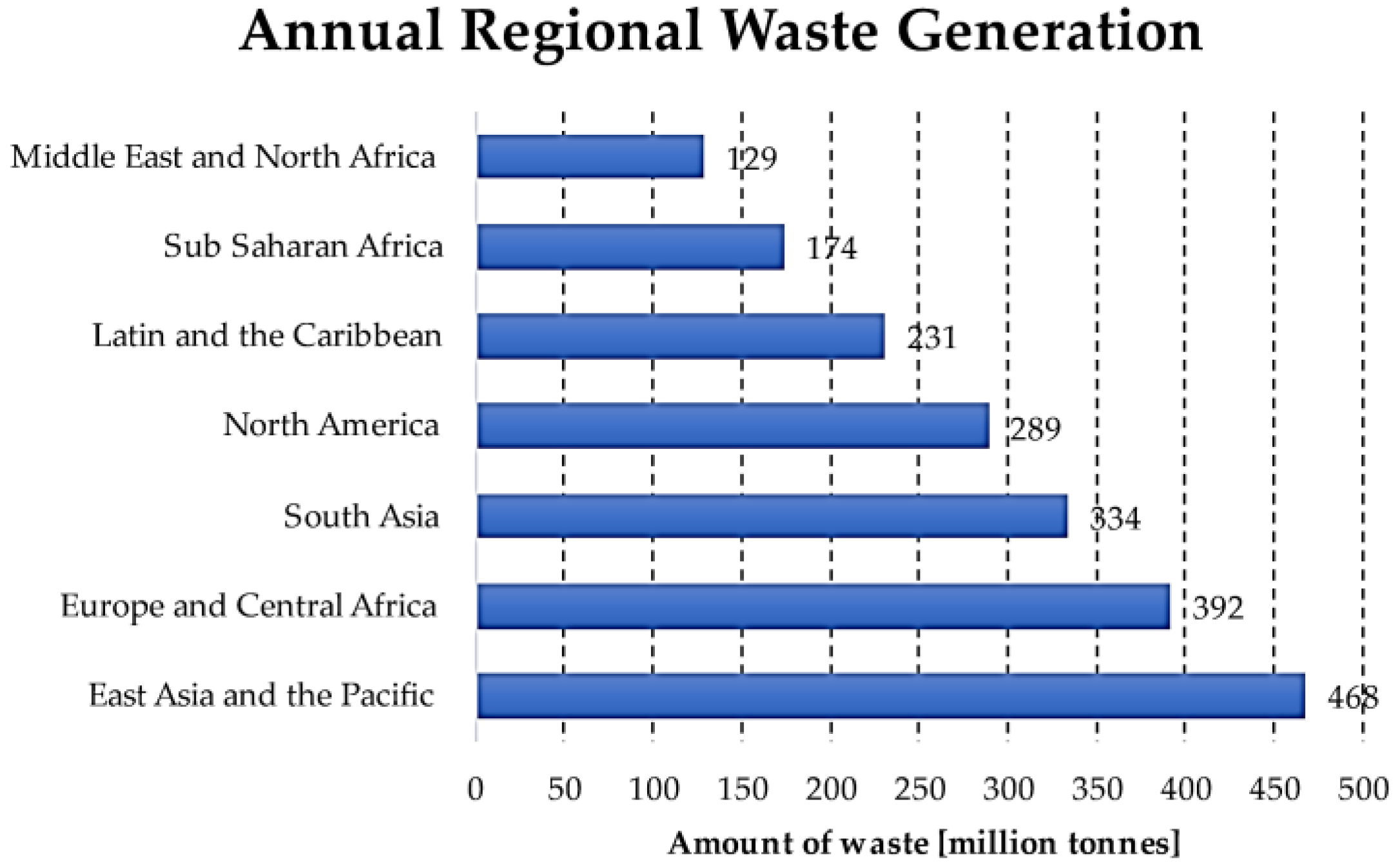
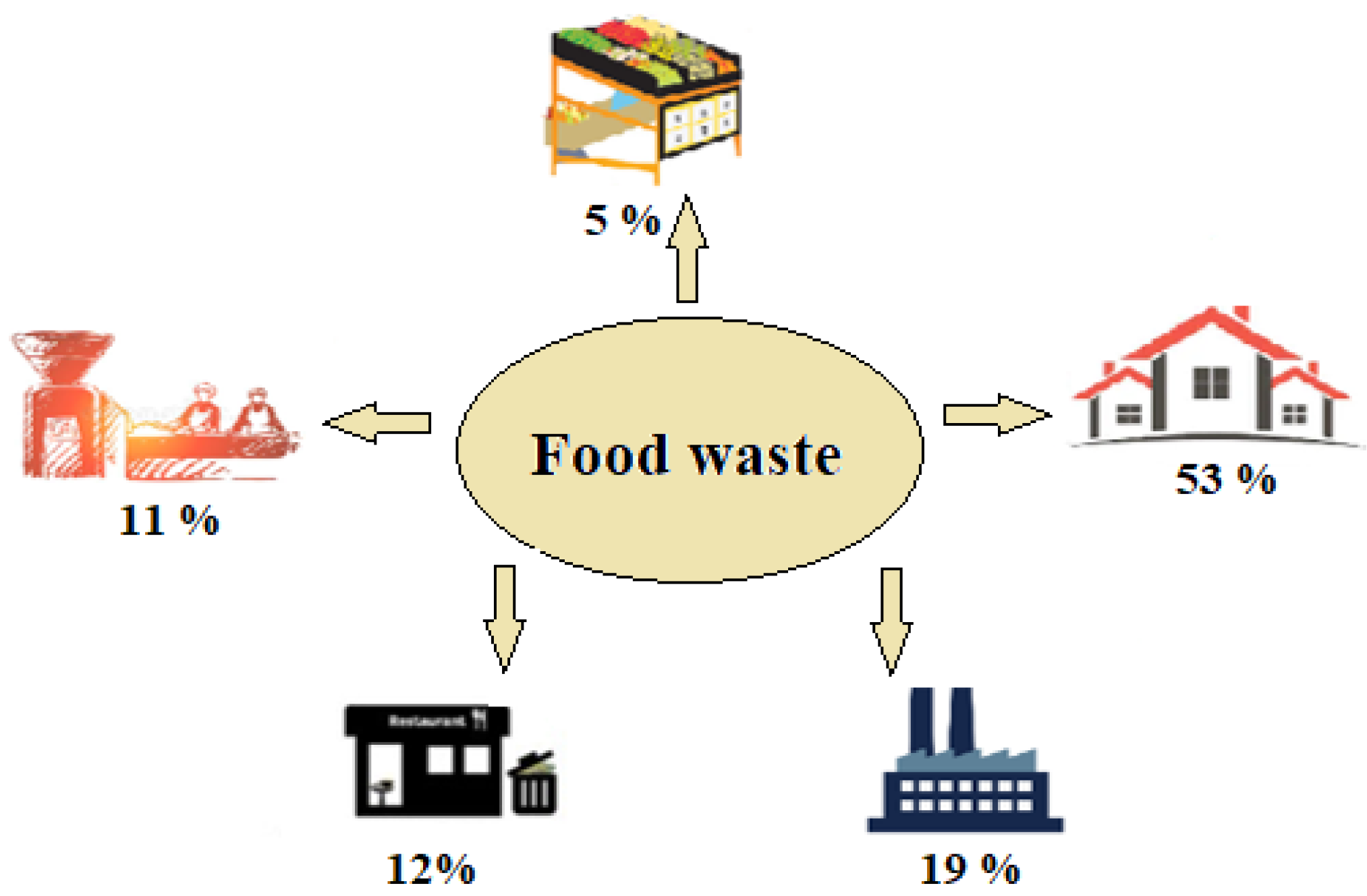

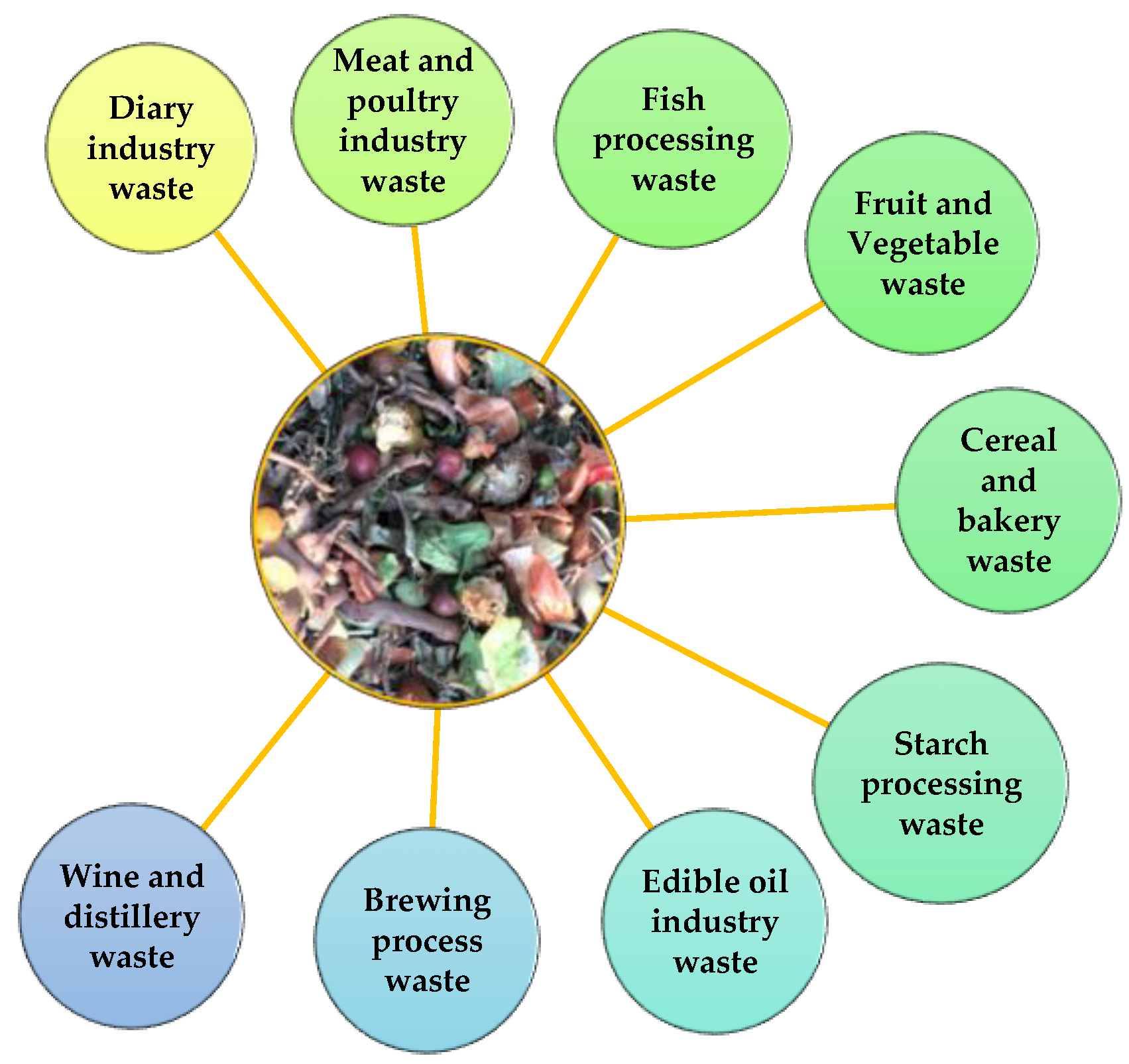
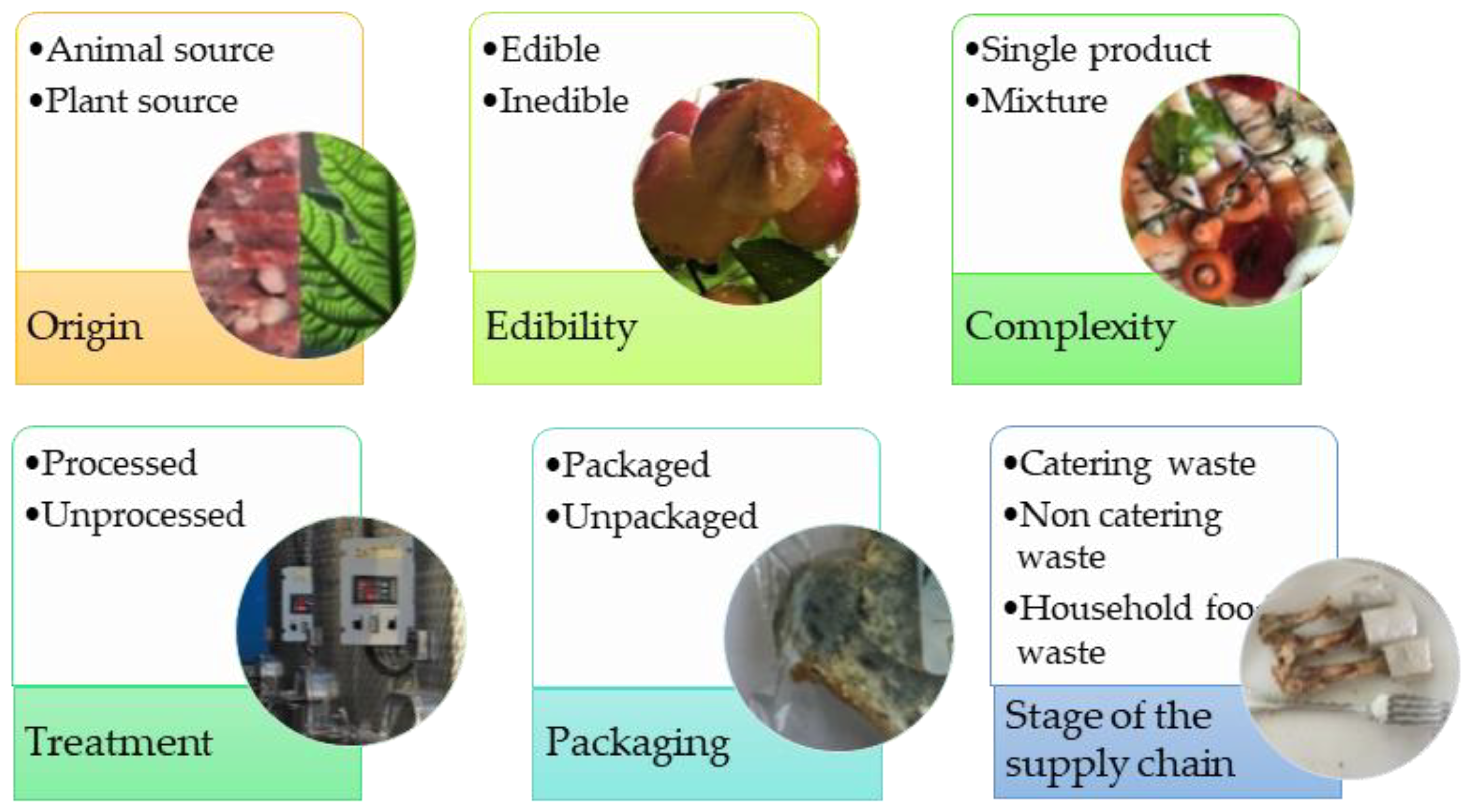
| Pretreatment | Substrate | Effect on Methane Yield (%) | References |
|---|---|---|---|
| Mechanical pretreatment (beads mill) | Food waste | +28% | [137] |
| Mechanical pretreatment (high voltage pulse discharge) | Food waste | +134% | [139] |
| Thermal pretreatment | Food waste | +24% | [22] |
| Irradiation pretreatment (Co-60 gamma-ray) | Food waste | +14.3% | [18] |
| Microwave pretreatment | Food waste + sludge | +19.93% | [149] |
| Microwave pretreatment | Food waste + poultry manure | +6.43 | [132] |
| Ultrasonication pretreatment | Food waste + poultry manure | +10.12 | [132] |
| Chemical pretreatment (dilute acid hydrolysis) | Bagasse | +31% | [112] |
| Chemical pretreatment (trace metal combination) | Food waste | +45–65% | [154] |
| Biological pretreatment (enzymatic) | Food waste + activated sludge | +2.5 times | [160] |
| Biological pretreatment (lipase) | Floatable grease of food waste | +37.0–40.7% | [159] |
Publisher’s Note: MDPI stays neutral with regard to jurisdictional claims in published maps and institutional affiliations. |
© 2022 by the authors. Licensee MDPI, Basel, Switzerland. This article is an open access article distributed under the terms and conditions of the Creative Commons Attribution (CC BY) license (https://creativecommons.org/licenses/by/4.0/).
Share and Cite
Ferdeș, M.; Zăbavă, B.Ș.; Paraschiv, G.; Ionescu, M.; Dincă, M.N.; Moiceanu, G. Food Waste Management for Biogas Production in the Context of Sustainable Development. Energies 2022, 15, 6268. https://doi.org/10.3390/en15176268
Ferdeș M, Zăbavă BȘ, Paraschiv G, Ionescu M, Dincă MN, Moiceanu G. Food Waste Management for Biogas Production in the Context of Sustainable Development. Energies. 2022; 15(17):6268. https://doi.org/10.3390/en15176268
Chicago/Turabian StyleFerdeș, Mariana, Bianca Ștefania Zăbavă, Gigel Paraschiv, Mariana Ionescu, Mirela Nicoleta Dincă, and Georgiana Moiceanu. 2022. "Food Waste Management for Biogas Production in the Context of Sustainable Development" Energies 15, no. 17: 6268. https://doi.org/10.3390/en15176268
APA StyleFerdeș, M., Zăbavă, B. Ș., Paraschiv, G., Ionescu, M., Dincă, M. N., & Moiceanu, G. (2022). Food Waste Management for Biogas Production in the Context of Sustainable Development. Energies, 15(17), 6268. https://doi.org/10.3390/en15176268







